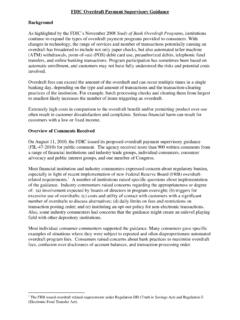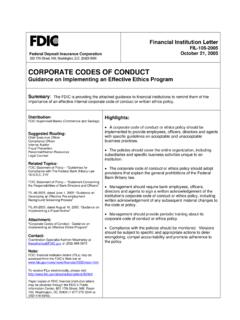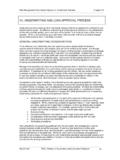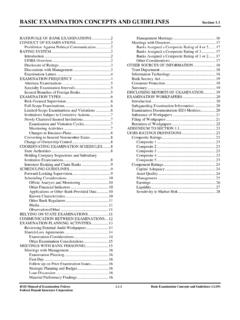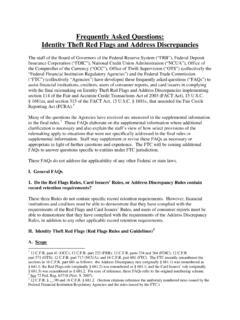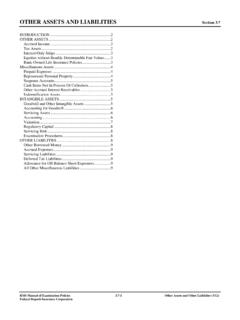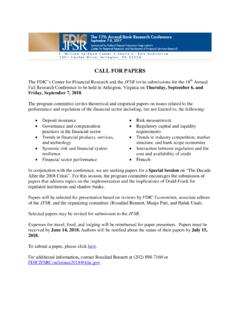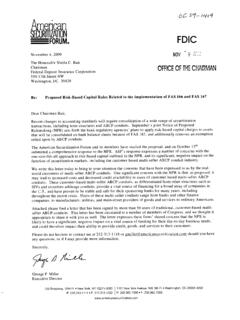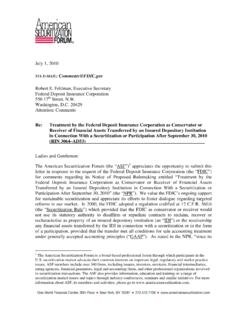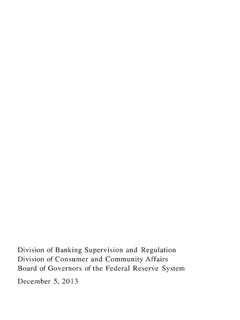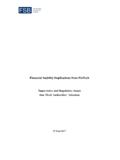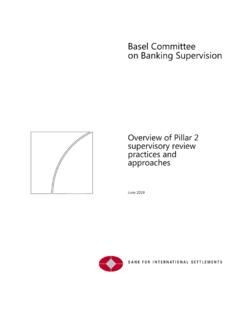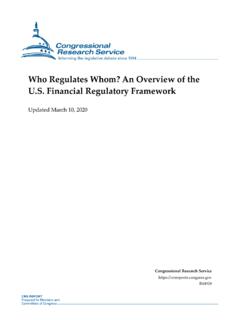Transcription of Overdraft Payment Programs (“ ”)
1 V. Lending Overdraft Payment Programs FDIC Consumer Compliance Examination Manual September 2015 V Overdraft Payment Programs Introduction Prior to the 1990s, Overdraft Programs were not common among financial institutions. Since that time, however, institutions have added and/or expanded the types of Overdraft Payment Programs provided to customers. Some of these Programs impose substantial fees and interest and rely on third-party vendors to develop systems to maximize the amount of fee income generated. Customer complaints have increased, along with reported legal and enforcement actions. In many cases, fees are repeatedly charged and are often disproportionate to the amount originally intended to be funded.
2 Some institutions manipulate their transaction processing order to maximize fee income. Customers have complained that they were not made aware of the existence or potential negative consequences of, or alternatives to, various types of Overdraft coverage. Some customers financial difficulties have been exacerbated by institutions Overdraft Payment practices and Programs , even though the institutions maintain alternative Programs more suitable for those customers. These circumstances can have an adverse impact on bank customers and present a potential risk of consumer harm. In an effort to assist FDIC-supervised institutions in identifying, managing, and mitigating risks regarding Overdraft Payment Programs , the FDIC issued its November 24, 2010, Overdraft Payment supervisory Guidance ( 2010 supervisory Guidance ) (FIL-81-2010).
3 The 2010 supervisory Guidance, which particularly focuses on the risks associated with excessive or chronic use of automated Overdraft Programs , is intended to serve as a comprehensive, up-to -date source of information about concerns and risks, as well as a summary of existing guidance and recent regulatory developments. In addition, the 2010 supervisory Guidance encourages FDIC-supervised institutions to promote responsible use of Overdraft Payment Programs through a series of specifically recommended actions institutions can take to help minimize the potential for consumer harm and regulatory or other risks. These Overdraft Payment program examination procedures: Incorporate recent changes to applicable laws and regulations; Integrate the supervisory expectations stated in the 2010 supervisory Guidance; and Reaffirm principles contained in the 2005 Interagency Joint Guidance on Overdraft Protection Programs ( Joint Guidance ) (FIL-11-2005) and the 2008 Guidance for Managing Third-Party Risk ( Third-Party Guidance )1 (FIL-44-2008).
4 The 2010 supervisory Guidance reaffirms existing laws, regulations, and guidance and addresses concerns regarding the risks posed by automated Programs and excessive use. The specific supervisory expectations set out in the 2010 supervisory Guidance with respect to excessive or chronic users of automated Overdraft Programs do not apply to ad hoc Overdraft practices. In April 2011, the FDIC published a set of Frequently Asked Questions to clarify the 2010 guidance and to respond to questions received from supervised institutions and third-party The Joint Guidance,3 Third-Party Guidance, and range of applicable laws and regulations potentially apply to any method of covering overdrafts, including automated Programs , linked accounts and lines of credit.
5 Examination Approach and Applicable Laws and Regulations The FDIC s risk-scoping examination approach requires compliance examiners to focus their attention to operational areas that present the greatest potential risk of consumer harm, as appropriate, including consideration of Overdraft Programs . Examiners should continue to reference appropriate chapters in the Compliance Examination Manual governing laws and regulations applicable to Overdraft Payment Programs . The scope of potentially applicable statutes and regulations that may apply to Overdraft Payment Programs includes: The Truth in Lending Act (TILA) and Regulation Z; The Truth in Savings Act (TISA) and Regulation DD; The Electronic Fund Transfer Act (EFTA) and Regulation E; Section 5 of the Federal Trade Commission Act (FTC Act) governing Unfair or Deceptive Acts or Practices (UDAPs); The Equal Credit Opportunity Act (ECOA) and Regulation B; The Expedited Funds Availability Act and Regulation CC; and The Community Reinvestment Act (CRA).
6 1 See Third-Party Risk Compliance Examination Procedures issued June 1, 2010. 2 On April 1, 2011, FDIC staff published a set of Frequently Asked Questions and answers in response to questions received from supervised institutions and third-party vendors about the 2010 supervisory Guidance, available at 3 Compliance examiners should pay particular attention to the Best Practices in the Joint Guidance, which cover both Marketing and Communications with Consumers and Program Features and Operation. V. Lending Overdraft Payment Programs V FDIC Consumer Compliance Examination Manual September 2015 Compliance examiners should apply the Overdraft Payment Program Compliance Examination Procedures and relevant laws and regulations, and refer to the 2010 supervisory Guidance, the Joint Guidance, and the Third-Party Guidance, as appropriate, to verify that institutions are adhering to applicable laws and regulations, and implementing appropriate policies, procedures, compliance management systems, and risk mitigation strategies.
7 Regulation E Changes Changes to laws and regulations place additional requirements on institutions Overdraft Payment Programs . Under Regulation E rules that took effect July 1, 2010, institutions must provide notice and a reasonable opportunity for customers to opt-in to the Payment of automated teller machine (ATM) and one-time, point-of-sale (POS) overdrafts provided in exchange for a fee. Institutions must also inform the customer if alternatives are In complying with these requirements, institutions should not attempt to steer frequent users of fee-based Overdraft products to opt-in to these Programs while obscuring the availability of alternatives. Targeting customers who may be least able to afford such products can raise safety-and-soundness concerns about potentially unsustainable customer debt.
8 Overly aggressive marketing, advertising, and other promotional activities require particular vigilance to ensure that they are not unfair or deceptive. Steering activity with respect to credit products raises potential legal issues, including fair lending, equal credit opportunity, and concerns about UDAPs, among others, and will be closely scrutinized. In addition, inconsistent application of waivers of Overdraft fees will be evaluated in light of all applicable fair lending statutes and regulations. Unfair or Deceptive Acts or Practices Section 5 of the FTC Act prohibits UDAPs in or affecting The FDIC enforces compliance with this important consumer protection law regarding FDIC-supervised institutions pursuant to its authority in the FTC Act and Section 8 of the Federal Deposit Insurance The prohibition against UDAPs applies to all products and services offered by financial institutions, including Overdraft services, and regardless of whether such services are offered directly or 4 See Regulation E (Electronic Fund Transfer Act) Examination Procedures.
9 In addition, as of January 1, 2010, Regulation DD (Truth in Savings) requires institutions to disclose on periodic statements the aggregate dollar amounts charged for Overdraft fees and for returned item fees, for the statement period and the year-to-date. It also requires institutions that provide account balance information through an automated system to provide a balance that does not include additional funds that may be made available to cover overdrafts. See Regulation DD Examination Procedures. 5 15 45(a). 6 See 12 1818(b). indirectly through a third party. Moreover, the prohibition applies to every stage and activity: from product development to the creation and rollout of the marketing campaign; from account maintenance and collections all the way through termination of the customer Community Reinvestment Act Institutions will continue to receive favorable CRA consideration under the service or lending tests (consistent with CRA regulations and FIL-50-2007 providing details on small dollar loans8), for offering financial education and positive alternatives to overdrafts that are responsive to the needs of customers, particularly low- and moderate-income individuals, in their local communities.
10 Examples include lower-cost transaction accounts and credit alternatives, such as a linked savings account, a small, reasonably priced line of credit consistent with safe and sound banking practices, or a safe and affordable small dollar loan. Third-Party Arrangements With the growth of third-party arrangements for Overdraft Payment Programs , Compliance examiners should ensure that financial institutions are managing these relationships in accordance with the principles outlined in the Third-Party In addition to general third-party oversight considerations, these third-party Overdraft Payment Programs may raise concerns that differ from potential issues related to in -house Programs .
